Fast food
 From Wikipedia - Reading time: 29 min
From Wikipedia - Reading time: 29 min
Fast food is a type of mass-produced food designed for commercial resale, with a strong priority placed on speed of service. Fast food is a commercial term, limited to food sold in a restaurant or store with frozen, preheated or precooked ingredients and served in packaging for take-out or takeaway. Fast food was created as a commercial strategy to accommodate large numbers of busy commuters, travelers and wage workers. In 2018, the fast-food industry was worth an estimated $570 billion globally.[1]
The fastest form of "fast food" consists of pre-cooked meals which reduce waiting periods to mere seconds. Other fast-food outlets, primarily hamburger outlets such as McDonald's and Burger King, use mass-produced, pre-prepared ingredients (bagged buns and condiments, frozen beef patties, vegetables which are pre-washed, pre-sliced, or both; etc.) and cook the meat and french fries fresh, before assembling "to order".
Fast-food restaurants are traditionally distinguished by the drive-through. Outlets may be stands or kiosks, which may provide no shelter or seating,[2] or fast-food restaurants (also known as quick-service restaurants).[3] Franchise operations that are part of restaurant chains have standardized foodstuffs shipped to each restaurant from central locations.[4]
Many fast foods tend to be high in saturated fat, sugar, salt and calories.[5] Fast-food consumption has been linked to increased risk of cardiovascular disease, colorectal cancer, obesity, high cholesterol, insulin resistance conditions and depression.[6][7][8][9] These correlations remain strong even when controlling for confounding lifestyle variables, suggesting a strong association between fast-food consumption and increased risk of disease and early mortality.[10]
History
[edit]
The concept of ready-cooked food for sale is closely connected with urban developments. Homes in emerging cities often lacked adequate space or proper food preparation accoutrements. Additionally, procuring cooking fuel could cost as much as purchased produce. Frying foods in vats of searing oil proved as dangerous as it was expensive. Homeowners feared that a rogue cooking fire "might easily conflagrate an entire neighborhood".[11]
Thus, urbanites were encouraged to purchase pre-prepared meats or starches, such as bread or noodles, whenever possible. This also ensured that customers with strictly limited time (a commuter stopping to procure dinner to bring home to their family, for example, or an hourly laborer on a short lunch break) were not inconvenienced by waiting for their food to be cooked on-the-spot (as is expected from a traditional "sit down" restaurant). In Ancient Rome, cities had street stands—a large counter with a receptacle in the middle from which food or drink would have been served.[12]
It was during post-WWII American economic boom that Americans began to spend more and buy more as the economy boomed and a culture of consumerism bloomed. As a result of this new desire to have it all, coupled with the strides made by women while the men were away, both members of the household began to work outside the home. Eating out, which had previously been considered a luxury, became a common occurrence, and then a necessity. Workers, and working families, needed quick service and inexpensive food for both lunch and dinner. The traditional family dinner is increasingly being replaced by the consumption of takeaway fast food. As a result, the time invested on food preparation is getting lower, with an average woman in the United States spending 47 minutes per day preparing food and the average man spending 19 minutes per day in 2013.[13]
Pre-industrial Old World
[edit]In the cities of Roman antiquity, much of the urban population living in insulae, multi-story apartment blocks, depended on food vendors for many of their meals; the Forum itself served as a marketplace where Romans could purchase baked goods and cured meats.[14] In the mornings, bread soaked in wine was eaten as a quick snack and cooked vegetables and stews later in popina, a simple type of eating establishment.[15] In Asia, 12th-century Chinese ate fried dough, soups and stuffed buns, all of which still exist as contemporary snack food.[16] Their Baghdadi contemporaries supplemented home-cooked meals with processed legumes, purchased starches, and even ready-to-eat meats.[17] During the Middle Ages, large towns and major urban areas such as London and Paris supported numerous vendors that sold dishes such as pies, pasties, flans, waffles, wafers, pancakes and cooked meats. As in Roman cities during antiquity, many of these establishments catered to those who did not have means to cook their own food, particularly single households. Unlike richer town dwellers, many often could not afford housing with kitchen facilities and thus relied on fast food. Travelers such as pilgrims en route to a holy site, were among the customers.[18]
United Kingdom
[edit]
In areas with access to coastal or tidal waters, 'fast food' frequently included local shellfish or seafood, such as oysters or, as in London, eels. Often this seafood was cooked directly on the quay or close by.[19] The development of trawler fishing in the mid-nineteenth century led to the development of a British favourite, fish and chips, and the first shop in 1860.[20]
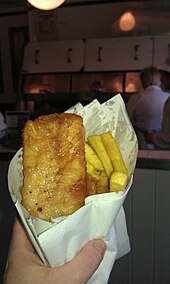
A blue plaque at Oldham's Tommyfield Market marks the origin of the fish and chip shop and fast food industries.[20] As a cheap fast food served in a wrapper, fish and chips became a stock meal among the Victorian working classes.[20] Via the Industrial Revolution, the fish and chip business expanded rapidly in Britain during the 19th century to satisfy the needs of the growing industrial population.[21] By 1910, there were more than 25,000 fish and chip shops across the UK, and in the 1920s there were more than 35,000 shops.[22] Harry Ramsden's fast food restaurant chain opened its first fish and chip shop in Guiseley, West Yorkshire in 1928. On a single day in 1952, the shop served 10,000 portions of fish and chips, earning a place in the Guinness Book of Records.[23]
British fast food had considerable regional variation. Sometimes the regionality of a dish became part of the culture of its respective area, such as the Cornish pasty and deep-fried Mars bar. The content of fast food pies has varied, with poultry (such as chickens) or wildfowl commonly being used. Since the Second World War, turkey has been used more frequently in fast food.[24] The UK has adopted fast food from other cultures as well, such as pizza, doner kebab, and curry. More recently, healthier alternatives to conventional fast food have also emerged.
United States
[edit]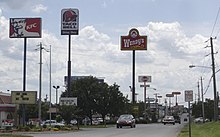
As automobiles became popular and more affordable following World War I, drive-in restaurants were introduced. The American company White Castle, founded by Billy Ingram and Walter Anderson in Wichita, Kansas in 1921, is generally credited with opening the first fast food outlet and first hamburger chain, selling hamburgers for five cents each.[25] Walter Anderson had built the first White Castle restaurant in Wichita in 1916, introducing the limited menu, high-volume, low-cost, high-speed hamburger restaurant.[26] Among its innovations, the company allowed customers to see the food being prepared. White Castle was successful from its inception and spawned numerous competitors.
Franchising was introduced in 1921 by A&W Root Beer, which franchised its distinctive syrup. Howard Johnson's first franchised the restaurant concept in the mid-1930s, formally standardizing menus, signage and advertising.[26]
Curb service was introduced in the late 1920s and was mobilized in the 1940s when carhops strapped on roller skates.[27]
The United States has the largest fast food industry in the world, and American fast food restaurants are located in over 100 countries. Approximately 5.4 million U.S. workers are employed in the areas of food preparation and food servicing, including fast food in the US as of 2018.[28] Worries of an obesity epidemic and its related illnesses have inspired many local government officials in the United States to propose to limit or regulate fast-food restaurants. Yet, US adults are unwilling to change their fast food consumption even in the face of rising costs and unemployment characterized by the great recession, suggesting an inelastic demand.[29] However, some areas are more affected than others. In Los Angeles County, for example, about 45% of the restaurants in South Central Los Angeles are fast-food chains or restaurants with minimal seating. By comparison, only 16% of those on the Westside are such restaurants.[30]
In 2023, the median age of a fast-food worker was 22, and workers' wages make up about one third of the cost of operating a fast food restaurant.[31]
On the go
[edit]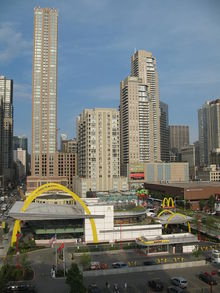
Fast food outlets are take-away or take-out providers that promise quick service. Such fast food outlets often come with a "drive-through" service that lets customers order and pick up food from their vehicles. Others have indoor or outdoor seating areas where customers can eat on-site. The boom in IT services has allowed customers to order food from their homes through their smartphone apps in recent times.
Nearly from its inception, fast food has been designed to be eaten "on the go," often does not require traditional cutlery, and is eaten as a finger food. Common menu items at fast food outlets include fish and chips, sandwiches, pitas, hamburgers, fried chicken, french fries, onion rings, chicken nuggets, tacos, pizza, hot dogs, and ice cream, though many fast food restaurants offer "slower" foods like chili, mashed potatoes, and salads.
Filling stations
[edit]Convenience stores located within many petrol/gas stations sell pre-packaged sandwiches, doughnuts, and hot food. Many gas stations in the United States and Europe also sell frozen foods, and have microwave ovens on the premises in which to prepare them. Petrol stations in Australia sell foods such as hot pies, sandwiches, and chocolate bars, which are easy for a customer to access while on their journey. Petrol stations are a place that are often open long hours and are open before and after shop trading hours, therefore, it makes it easy to access for consumers.
Street vendors and concessions
[edit]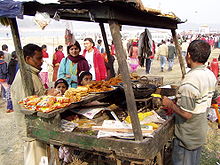

Traditional street food is available around the world, usually through small and independent vendors operating from a cart, table, portable grill or motor vehicle. Common examples include Vietnamese rice soup vendors, Middle Eastern falafel stands, New York City hot dog carts, and taco trucks. Turo-Turo vendors (Tagalog for point point) are a feature of Philippine life. Commonly, street vendors provide a colorful and varying range of options designed to captivate passers-by and attract as much attention as possible quickly.
Multiple street vendors may specialize in specific types of food; typically, they are characteristic of a given cultural or ethnic tradition depending on the locale. In some cultures, it is typical for street vendors to call out prices, sing or chant sales-pitches, play music, or engage in other forms of "street theatrics" to engage prospective customers. In some cases, this can garner more attention than the food.[citation needed]
Cuisine
[edit]
Modern commercial fast food is often ultra-processed food and prepared in an industrial fashion, i.e., on a large scale with standard ingredients and standardized cooking and production methods.[32] It is usually rapidly served in cartons or bags or in plastic wrapping, in a fashion that minimizes cost. In most fast food operations, menu items are generally made from processed ingredients prepared at a central supply facility and then shipped to individual outlets where they are reheated, cooked (usually by microwave or deep frying) or assembled in a short amount of time. This process ensures a consistent level of product quality. It is key to being able to deliver the order quickly to the customer and eliminate labor and equipment costs in the individual stores.
Because of commercial emphasis on quickness, uniformity and low cost, fast food products are often made with ingredients formulated to achieve a certain flavor or consistency and to preserve freshness.
Variants
[edit]
Chinese takeaways/takeout restaurants are particularly popular in Western countries such as the US and UK. They normally offer a wide variety of Asian food (not always Chinese), which has normally been fried. Most options are some form of noodles, rice, or meat. In some cases, the food is presented as a smörgåsbord, sometimes self service. The customer chooses the size of the container they wish to buy, and then is free to fill it with their choice of food. It is common to combine several options in one container, and some outlets charge by weight rather than by item. In large cities, these restaurants may offer free delivery for purchases over a minimum amount.
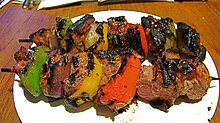
Sushi has seen rapidly rising popularity recently in the Western world. A form of fast food created in Japan (where bentō is the Japanese variety of fast food), sushi is normally cold sticky rice flavored with a sweet rice vinegar and served with some topping (often fish), or, as in the most popular kind in the West, rolled in nori (dried green laver) with filling. The filling often includes fish, seafood, chicken or cucumber.
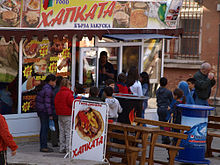
Pizza is a common fast food category in the United States, with nationwide chains including Papa John's, Domino's Pizza, Sbarro and Pizza Hut. It trails only the burger industry in supplying children's fast food calories.[33] Menus are more limited and standardized than in traditional pizzerias, and pizza delivery is offered.
Kebab houses are a form of fast food restaurant from the Middle East, especially Turkey and Lebanon. Meat is shaven from a rotisserie, and is served on a warmed flatbread with salad and a choice of sauce and dressing. These doner kebabs or shawarmas are distinct from shish kebabs served on sticks. Kebab shops are also found throughout the world, especially Europe, New Zealand and Australia but they generally are less common in the US.
Fish and chip shops are a form of fast food popular in the United Kingdom, Australia and New Zealand. Fish is battered and then deep fried, and served with deep-fried potato strips.[34]

The Dutch have their own types of fast food. A Dutch fast food meal often consists of a portion of french fries (called friet or patat) with a sauce and a meat product. The most common sauce to accompany french fries is fritessaus. It is a sweet, vinegary and low fat mayonnaise substitute, that the Dutch nevertheless still call "mayonnaise". When ordering it is very often abbreviated to met (literally "with"). Other popular sauces are ketchup or spiced ketchup ("curry"), Indonesian style peanut sauce ("satésaus" or "pindasaus") or piccalilli. Sometimes the fries are served with combinations of sauces, most famously speciaal (special): mayonnaise, with (spiced) ketchup and chopped onions; and oorlog (literally "war"): mayonnaise and peanut sauce (sometimes also with ketchup and chopped onions). The meat product is usually a deep fried snack; this includes the frikandel (a deep fried skinless minced meat sausage), and the kroket (deep fried meat ragout covered in breadcrumbs).
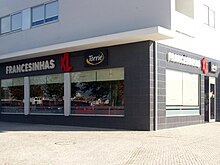

In Portugal, there are some varieties of local fast-food and restaurants specialized in this type of local cuisine. Some of the most popular foods include frango assado (Piri-piri grilled chicken previously marinated), francesinha, francesinha poveira, espetada (turkey or pork meat on two sticks) and bifanas (pork cutlets in a specific sauce served as a sandwich). This type of food is also often served with french fries (called batatas fritas), some international chains started appearing specialized in some of the typical Portuguese fast food such as Nando's.
An example of a local form of fast food in Poland is pasztecik szczeciński, a deep-fried yeast dough stuffed with meat or vegetarian filling, typical fast food dish of the city of Szczecin well known in many other cities in the country. A dish is on Polish List of traditional products. The first bar serving pasztecik szczeciński, Bar "Pasztecik" founded in 1969, is located on Wojska Polskiego Avenue 46 in Szczecin.
A fixture of East Asian cities is the noodle shop. Flatbread and falafel are today ubiquitous in the Middle East. Popular Indian fast food dishes include vada pav, panipuri and dahi vada. In the French-speaking nations of West Africa, roadside stands in and around the larger cities continue to sell—as they have done for generations—a range of ready-to-eat, char-grilled meat sticks known locally as brochettes (not to be confused with the bread snack of the same name found in Europe)
Business
[edit]In the United States, consumers spent $160 billion on fast food in 2012 (up from $6 billion in 1970).[35][36] In 2013, the US restaurant industry had total projected sales of $660.5 billion.[37] Fast food has been losing market share to fast casual dining restaurants, which offer more robust and expensive cuisines.[38] Due to this competition, fast food giants have seen dramatic drops in their sales.[39] While overall fast food sales have fallen, the number of Americans who eat in these restaurants "once a month or 'a few times a year'" has risen.[39]
In contrast to the rest of the world, American citizens spend a much smaller amount of their income on food — largely due to various government subsidies that make fast food cheap and easily accessible.[40] Calorie for calorie, foods sold in fast food restaurants, costs less and is more energy-dense, and is made mostly of products that the government subsidizes heavily: corn, soy, and beef.[41]
The Australian fast food market is valued at more than 2.7 billion GPB and is composed of 1.4 billion fast food meals. This includes meals serviced at 17,000 fast food outlets. The fast food market has experienced an average annual growth rate of 6.5 percent, which is the most rapidly growing sector of the retail food market.[42]
Advertising
[edit]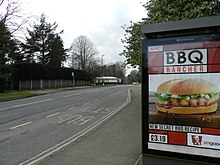
In 2012, fast food restaurants spent roughly US$4.6 billion on advertising campaigns, which represented an 8% increase from 2009. In the same period of time, McDonald's spent nearly three times as much on advertising as all water, milk, and produce advertisers spent combined.[43]
A study done by researchers from the Geisel School of Medicine at Dartmouth College saw results that suggest that when children watch more commercial television (and see more advertisements on fast food), they are more inclined to ask to visit these subsequent fast food restaurants.[44] Specifically, fast food restaurants have been increasing their advertising efforts that target Black and Hispanic youth.[45] A 2021 report from the Rudd Center for Food Policy & Obesity indicated that fast-food restaurants spent about $318 million on Spanish-language TV channels. The same report found that fast-food restaurants spent about $99 million on majority Black viewer TV channels. Black youth groups viewed fast-food advertisements about more than white youth groups.[46]
The Council of Better Business Bureaus started the Children's Food and Beverage Advertising Initiative in 2006 which asked fast food companies to pledge to "advertise only more healthful products to children" with McDonald's and Burger King signing on.[44] However, despite a slight increase in healthful food advertising, the effectiveness of this initiative has been disputed by studies that reveal that "children couldn't remember or identify healthful foods in the ads, and that 81 percent of the 99 3 to 7 year olds in that study recalled French fries" even though there were no french fries in the advertisement.[47]
Employment
[edit]This section needs to be updated. (April 2022) |
According to the U.S. Bureau of Labor Statistics, about 4.1 million U.S. workers are employed in food preparation and serving (including fast food) as of 2010.[28] The BLS's projected job outlook expects average growth and excellent opportunity as a result of high turnover. However, in April 2011, McDonald's hired approximately 62,000 new workers and received a million applications for those positions—an acceptance rate of 6.2%.[48] The median age of workers in the industry in 2013 was 28.[49] Obtaining Human Resource Management diploma or diploma in Fast Food Management can help to get a job in major fast food restaurants since it is one of the most desired.[50]
Globalization
[edit]This section may be confusing or unclear to readers. (April 2012) |


In 2006, the global fast-food market grew by 4.8% and reached a value of £102.4 billion and a volume of 80.3 billion transactions.[51] McDonald's alone, has outlets in 126 countries on 6 continents and operates over 31,000 restaurants worldwide.[52]
One example of McDonald's expansion on a global scale was its introduction to the Russian market. In order for the American business to succeed it would have to be accepted and integrated into the daily lives of natives in Moscow. Thus, the restaurant was strategically implemented so that its offerings would align with the distinct and established eating habits, also known as the customs around food, eating and cooking, of Muscovites. One significant characteristic of Russian food culture is the emphasis on knowing about the locality of goods that are consumed. Essentially, in order to successfully launch this American brand in a foreign country, McDonald's interpreted the local interests of consumers in Moscow by promoting the origins of the produce used in the restaurant.[53] On January 31, 1990, McDonald's opened a restaurant in Moscow and broke opening-day records for customers served. The Moscow restaurant is the busiest in the world.
The largest McDonald's in the world, with 25,000 feet of play tubes, an arcade and play center, is located in Orlando, Florida, United States[54][clarification needed]
There are numerous other fast food restaurants located all over the world. Burger King has more than 11,100 restaurants in more than 65 countries.[55] KFC is located in 25 countries.[56] Subway is one of the fastest growing franchises in the world with approximately 39,129 restaurants in 90 countries as of May 2009,[57] the first non-US location opening in December 1984 in Bahrain.[58] Wienerwald has spread from Germany into Asia[59] and Africa.[60] Pizza Hut is located in 97 countries, with 100 locations in China.[61] Taco Bell has 278 restaurants located in 14 countries besides the United States.[62]
Criticism
[edit]Fast-food chains have come under criticism over concerns ranging from claimed negative health effects, alleged animal cruelty, cases of worker exploitation, and claims of cultural degradation via shifts in people's eating patterns away from traditional foods.[63][64][65][66][67][68][69][70][71][72][73][74][75][76]
The intake of fast food is increasing worldwide. A study done in the city of Jeddah has shown that current fast-food habits are related to the increase of overweight and obesity among adolescents in Saudi Arabia.[77] In 2014, the World Health Organization published a study which claims that deregulated food markets are largely to blame for the obesity crisis, and suggested tighter regulations to reverse the trend.[78] In the United States, local governments are restricting fast-food chains by limiting the number of restaurants found in certain geographical areas.[79]
To combat criticism, fast-food restaurants are starting to offer more health-friendly menu items.[80] In addition to health criticisms, there are suggestions for the fast-food industry to become more eco-friendly. The chains have responded by "reducing packaging waste".[80]
Although trying to overcome criticism through healthy options on fast-food menus, Marion Nestle, who serves as the chair of New York University's Department of Nutrition and Food Studies, suggests that fast-food industries intentionally market unhealthy foods to children through advertising options and therefore create customers for life.[81]
Despite so much popularity, fast foods and fast-food chains have adverse impacts not only on the job and social skills, but on the health and academic performance of students. Fifty-six percent of students consume fast food on a weekly basis.[82] The researcher who wrote Fast Food Nation, Eric Schlosser, highlights this fact, arguing that this is not only a financial but also a psychological bait, in that the students are lured towards this early employment opportunity knowing little that the time spent on this no-skill-learning job is wasted.[83] The dangerous impacts and consequences regarding the hiring and firing of teenage school-goers in the fast-food industry have also been a point of criticism of the fast-food industry.[84] Kelly Brownwell of The Atlantic has further supported this argument that Burger King and McDonald's adopted another dangerous practice for marketing to innocent children.[85]
In a research study conducted by Professors Purtell Kelly and Gershoff, they found that the students of fifth grades, who ate fast foods as compared to the students of the same age after some other social factors were controlled.[clarify] Also, the percentage of the students having consumed fast food and showed poor grades was around 11 percent more than those who used organic foods. They are of the view that other social factors such as television-watching, video games and playing were controlled to assess the real impacts of fast foods.[86]
There have been books and films, such as the 2004 film Super Size Me, designed to highlight the potential negative health effects from the overconsumption of fast food, such as its contribution to obesity.[87]
See also
[edit]References
[edit]- ^ "Fast Food Industry Analysis 2018 – Cost & Trends". franchisehelp.com. Franchise Help. 2018. p. 1. Archived from the original on July 16, 2019. Retrieved July 16, 2019.
- ^ Jakle, John (1999). Fast Food: Roadside Restaurants in the Automobile Age. Johns Hopkins University Press. ISBN 978-0-8018-6920-4.; Brueggemann, Walter (1993). Texts Under Negotiation: The Bible and Postmodern Imagination. Fortress Press. ISBN 978-0-8006-2736-2.
- ^ "Quick Service Restaurants (QSR) Market Worth USD 577.71 Billion by 2028 at 3.65% CAGR – Report by Market Research Future (MRFR)". GlobeNewswire (Press release). August 18, 2021. Archived from the original on August 26, 2021. Retrieved August 26, 2021.
- ^ Talwar, Jennifer (2003). Fast Food, Fast Track: Immigrants, Big Business, and the American Dream. Westview Press. ISBN 978-0-8133-4155-2.
- ^ Hellesvig-Gaskell, Karen. "Definition of Fast Foods | LIVESTRONG.COM". LIVESTRONG.COM. Archived from the original on March 2, 2022. Retrieved May 3, 2016.
- ^ "The link between fast food and depression has been confirmed". EurekAlert!. Archived from the original on April 23, 2018. Retrieved April 22, 2018.
- ^ "Susan Cohan Colon Cancer Foundation: Prevention: Eating Well/Diet". coloncancerfoundation.org. Archived from the original on October 18, 2016. Retrieved August 16, 2016.
- ^ Publications, Harvard Health. "Red meat and colon cancer – Harvard Health". Archived from the original on December 22, 2016. Retrieved August 16, 2016.
- ^ Bao, Wei; Tobias, Deirdre K.; Olsen, Sjurdur F.; Zhang, Cuilin (December 1, 2014). "Pre-pregnancy fried food consumption and the risk of gestational diabetes mellitus: a prospective cohort study". Diabetologia. 57 (12): 2485–2491. doi:10.1007/s00125-014-3382-x. ISSN 1432-0428. PMC 4221538. PMID 25303998.
- ^ Pan, An; Malik, Vasanti; Hu, Frank B. (July 10, 2012). "Exporting Diabetes to Asia: The Impact of Western-Style Fast Food". Circulation. 126 (2): 163–165. doi:10.1161/CIRCULATIONAHA.112.115923. ISSN 0009-7322. PMC 3401093. PMID 22753305.
- ^ Laudan, Rachel (2001). "A Plea for Culinary Modernism: Why We Should Love New, Fast, Processed Food". Gastronomica: The Journal of Critical Food Studies. 1: 36–44. doi:10.1525/gfc.2001.1.1.36. S2CID 154951102.
- ^ "Ancient Romans preferred fast food". ABC Science. June 19, 2007. Archived from the original on December 29, 2015. Retrieved June 30, 2016.
- ^ Jaworowska, Agnieszka; Blackham, Toni; Davies, Ian G.; Stevenson, Leonard (May 1, 2013). "Nutritional challenges and health implications of takeaway and fast food" (PDF). Nutrition Reviews. 71 (5): 310–318. doi:10.1111/nure.12031. ISSN 0029-6643. PMID 23590707. S2CID 20897192. Archived (PDF) from the original on September 8, 2021. Retrieved May 10, 2021.
- ^ Dupont, Florence (1992). Daily Life in Ancient Rome. Oxford: Blackwell. p. 181.
- ^ Stambaugh, John E. (1988). The Ancient Roman City. JHU Press. pp. 200, 209. ISBN 978-0-8018-3692-3.
- ^ Chang, Kwang-chih (1977). Food in Chinese Culture: Anthropological and Historical Perspectives. New Haven: Yale University Press.
- ^ Le Strange, G. (1924). Baghdad during the Abbasid Caliphate from Contemporary Arabic and Persian Sources, 81–82. London: Oxford University Press. pp. 81–82.
- ^ Carling, Martha (2003). Food and Eating in Medieval Europe. Bloomsbury Academic. pp. 27–51. ISBN 978-1-85285-148-4.
- ^ BBC (August 31, 2006). "Eel and pie shop". BBC. Archived from the original on March 7, 2008. Retrieved November 24, 2007.
- ^ a b c Webb, Andrew (2011). Food Britannia. Random House. p. 397.
- ^ "The History of Fish and Chips". Historic England. Archived from the original on June 8, 2023. Retrieved November 4, 2023.
- ^ Alexander, James (December 18, 2009). "The unlikely origin of fish and chips". BBC News. Archived from the original on August 26, 2017. Retrieved July 16, 2013.
- ^ "Harry Ramsden's famous original fish and chip shop faces closure after losses" Archived January 7, 2018, at the Wayback Machine. The Guardian. Retrieved January 6, 2018
- ^ BBC News (February 7, 2007). "How turkey became a fast food". BBC. Archived from the original on December 6, 2007. Retrieved November 23, 2007.
- ^ National Public Radio (2002). "The Hamburger". NPR. Archived from the original on December 22, 2007. Retrieved November 23, 2007.
- ^ a b James P Farrell. "The Evolution of the Quick Service Restaurant". A Management Consultant @ Large. Archived from the original on May 11, 2008. Retrieved February 14, 2008.
- ^ Mcginley, Lou Ellen (2004). Honk for Service, a Man, a Tray, and the Glory Days of the Drive-in. Tray Days Publishing. ISBN 978-0-615-12697-5.
- ^ a b "BLS.gov: Food and Beverage Serving and Related Workers". December 17, 2015. Archived from the original on March 11, 2015. Retrieved April 6, 2016.
- ^ Smith, Lindsey P.; Ng, Shu Wen; Popkin, Barry M. (May 1, 2014). "Resistant to the recession: low-income adults' maintenance of cooking and away-from-home eating behaviors during times of economic turbulence". American Journal of Public Health. 104 (5): 840–846. doi:10.2105/AJPH.2013.301677. ISSN 1541-0048. PMC 3987573. PMID 24625145.
- ^ Tami Abdollah (September 10, 2007). "A strict order for fast food". Los Angeles Times. Archived from the original on December 29, 2013. Retrieved December 27, 2013.
- ^ Chang, Andrea; Lee, Don (March 27, 2024). "Higher prices on the menu as fast-food chains brace for California's big minimum wage jump". Los Angeles Times.
...labor accounts for roughly a third of a typical fast-food operator's expenses. ... Over the years, the average age of fast-food workers in the U.S. has been rising gradually as many teens have instead sought enrichment jobs to prepare for college. The median age for fast-food workers is now 22.1, according to the Bureau of Labor Statistics.
- ^ Monteiro, C.A.; Moubarac, J.-C.; Cannon, G.; Ng, S.W.; Popkin, B. (2013). "Ultra-processed products are becoming dominant in the global food system". Obesity Reviews. 14 (Suppl 2): 21–8. doi:10.1111/obr.12107. PMID 24102801. S2CID 13735684.
- ^ Rehm, Colin D.; Drewnowski, Adam (2014). "A New Method to Monitor the Contribution of Fast Food Restaurants to the Diets of US Children". PLOS ONE. 9 (7): e103543. Bibcode:2014PLoSO...9j3543R. doi:10.1371/journal.pone.0103543. PMC 4111613. PMID 25062277.
- ^ "Federation of Fish Friers – Serving the Fish and Chips Industry – History". Archived from the original on December 18, 2012. Retrieved May 24, 2015.
- ^ "Fast Food Industry Analysis 2015 – Cost & Trends". Archived from the original on March 17, 2015. Retrieved May 24, 2015.
- ^ Schlosser, Eric (2001). Fast Food Nation: The Dark Side of the All-American Meal. Houghton Mifflin Books. ISBN 978-0-395-97789-7.
- ^ "NRA Pocket Factbook" (PDF). National Restaurant Association. 2013. Archived from the original (PDF) on March 4, 2016. Retrieved April 6, 2016.
- ^ John Eligon (January 13, 2008). "Where to Eat? A New Restaurant Genre Offers Manhattan More Choices". The New York Times. Archived from the original on April 17, 2009. Retrieved December 30, 2008.
Though still a relatively small sector within the nation's $350 billion restaurant industry, several fast-casual chains are showing success and growth in Manhattan, and industry experts say it could be a sign of the sector's maturity and sustainability nationwide.
- ^ a b Kiener, Robert (October 3, 2014). "Food Policy Debates". CQ Researcher. 24 (35). Archived from the original on May 15, 2023. Retrieved May 15, 2023.
- ^ "Commodity Policy and Agricultural Subsidies". Yale Rudd Center for Food Policy and Obesity. January 1, 2013. Archived from the original on March 28, 2014. Retrieved August 18, 2014.
{{cite web}}: CS1 maint: unfit URL (link) - ^ Parker-Pope, Tara (December 5, 2007). "A High Price for Healthy Food". The New York Times. Archived from the original on August 21, 2014. Retrieved August 17, 2014.
- ^ Cameron Allan; Greg J. Bamber; Nils Timo (September 1, 2006). "Fast-food work: are McJobs satisfying?". Employee Relations. 28 (5): 402–420. doi:10.1108/01425450610683627. ISSN 0142-5455.
- ^ University, Yale. "Fast Food FACTS — Fast Food Facts in Brief". www.fastfoodmarketing.org. Archived from the original on May 12, 2017. Retrieved April 18, 2017.
- ^ a b Dell’Antonia, KJ (October 30, 2015). "More Research Suggests Fast-Food Advertising Works on Children". Motherlode Blog. The New York Times. Archived from the original on February 6, 2017. Retrieved April 18, 2017.
- ^ "Report: Rise in fast-food advertising largely targets Black, Hispanic youths". UPI. Archived from the original on June 17, 2021. Retrieved June 17, 2021.
- ^ Harris, Jennifer L., Frances Fleming-Milici, Lindsay Phaneuf, Melissa Jensen, Yoon Young Choi, Melissa McCann, Sally Mancini. Fast food advertising: Billions in spending, continued high exposure by youth Archived June 17, 2021, at the Wayback Machine
- ^ Bernhardt, Amy M.; Wilking, Cara; Gottlieb, Mark (May 2014). "Children's Reaction to Depictions of Healthy Foods in Fast-Food Television Advertisements". JAMA Pediatrics. 168 (5): 422–426. doi:10.1001/jamapediatrics.2014.140. PMID 24686476. S2CID 38991522. Archived from the original on April 19, 2017. Retrieved April 20, 2017.
- ^ "It's Harder To Get A Job At McDonald's Than It Is To Get Into Harvard". Business Insider. April 28, 2011. Archived from the original on May 18, 2015. Retrieved May 24, 2015.
- ^ Owens, Christine (August 29, 2013). "Trying to raise a family on a fast-food salary". Reuters. Archived from the original on August 31, 2013. Retrieved April 8, 2016.
- ^ "Fast Food Job Applications". Archived from the original on August 30, 2019. Retrieved June 22, 2016.
- ^ "Our Life Policy Research Notes on takeaways – The UK fast-food market" (PDF). Archived from the original (PDF) on January 14, 2013. Retrieved July 28, 2012.
- ^ "The Fast Food Factory". Archived from the original on October 12, 2007. Retrieved April 29, 2008.
- ^ Caldwell, Melissa L. "Domesticating the French Fry: McDonald’s and Consumerism in Moscow." Journal of Consumer Culture 4.1 (2004): 5–26. Web. January 30, 2017.
- ^ "World's Largest McDonald's in Orlando, FL". Archived from the original on March 18, 2016. Retrieved May 24, 2015.
- ^ "Burger King". Archived from the original on April 15, 1997. Retrieved April 29, 2008.
- ^ "KFC". Archived from the original on February 24, 2011. Retrieved April 29, 2008.
- ^ Subway publication (2008). "Official SUBWAY Restaurants Web Site". Subway Restaurants. Archived from the original on October 19, 2000. Retrieved May 24, 2009.
- ^ "Subway". Archived from the original on October 19, 2000. Retrieved April 29, 2008.
- ^ "Wienerwald – Türkiye – Restoranlar". Archived from the original on May 23, 2015. Retrieved May 24, 2015.
- ^ "WIENERWALD – Restaurants in Egypt". Archived from the original on February 21, 2020. Retrieved May 24, 2015.
- ^ "Yum! Brands". Archived from the original on February 8, 2010. Retrieved October 26, 2009.
- ^ "Taco Bell". Archived from the original on April 11, 2017. Retrieved April 29, 2008.
- ^ Jeffery, Robert (January 25, 2006). "Are fast food restaurants an environmental risk factor for obesity?". International Journal of Behavioral Nutrition and Physical Activity. 3: 2. doi:10.1186/1479-5868-3-2. PMC 1397859. PMID 16436207.
- ^ Freeman, Andrea (December 6, 2007). "Fast Food: Oppression through Poor Nutrition". California Law Review. 95 (6): 2221–2259. JSTOR 20439143.
- ^ Ronald, Adams (September 8, 2008). "Fast Food and Animal Rights: An Examination and Assessment of the Industry's Response to Social Pressure". Business and Society Review. 113 (3): 301–328. doi:10.1111/j.1467-8594.2008.00322.x. S2CID 154438433.
- ^ Singer, Peter; Mason, Jim. The Ethics of What We Eat: Why Our Food Choices Matter. Holtzbrink Publishers. 2006.
- ^ Singer, P (1975). Animal liberation. New York review. ISBN 978-0-394-40096-9. Archived from the original on October 4, 2013. Retrieved October 3, 2013.
- ^ Schlosser, Eric. Fast Food Nation: The Dark Side of the All-American Meal. Harper Collins Publishers. 2001
- ^ Smith, Vicki (November 4, 1998). "The Fractured World of the Temporary Worker: Power, Participation, and Fragmentation in the Contemporary Workplace". Social Problems. 45 (4): 411–430. doi:10.2307/3097205. JSTOR 3097205.
- ^ Duffey, Kiyah (January 2007). "Differential associations of fast food and restaurant food consumption with 3-y change in body mass index: the Coronary Artery Risk Development in Young Adults Study". The American Journal of Clinical Nutrition. 85 (1): 201–8. doi:10.1093/ajcn/85.1.201. PMID 17209197. Archived from the original on March 27, 2017. Retrieved April 8, 2016.
- ^ French, Simone (May 2001). "Environmental Influences on Eating and Physical Activity". Annual Review of Public Health. 22: 309–35. doi:10.1146/annurev.publhealth.22.1.309. PMID 11274524.
- ^ James F. Sallis, Karen Glanz. "The Role of Built Environments in Physical Activity, Eating, and Obesity in Childhood Archived January 1, 2019, at the Wayback Machine". The Future of Children Volume 16, Number 1, Spring 2006 pp. 89–108 | 10.1353/foc.2006.0009. Alternative link Archived March 4, 2016, at the Wayback Machine
- ^ Walshe, Sadhbh. The Guardian. "How America's fast food industry makes a quick buck. The gulf between CEO pay and staff McWages is shockingly wide: a strike serves this system of super-exploitation right". April 10, 2013 Archived December 26, 2016, at the Wayback Machine
- ^ Michelle Mello, Eric B. Rimm and David M. Studdert. "The McLawsuit: The Fast-Food Industry and Legal Accountability for Obesity". Health Affairs. November 2003. vol. 22 no. 6 207–216. Archived August 28, 2014, at the Wayback Machine.
- ^ Shanthy A. Bowman, Steven L. Gortmaker, Cara B. Ebbeling, Mark A. Pereira, David S. Ludwig. "Effects of Fast-Food Consumption on Energy Intake and Diet Quality Among Children in a National Household Survey". Pediatrics Vol. 113 No. January 1, 1, 2004 pp. 112–118 Archived December 14, 2012, at the Wayback Machine
- ^ Hossein Rouhani, Mohammad; Mirseifinezhad, Maryam; Omrani, Nasrin; Esmaillzadeh, Ahmad; Azadbakht, Leila (2012). "Fast Food Consumption, Quality of Diet, and Obesity among Isfahanian Adolescent Girls". Journal of Obesity. 2012: 597924. doi:10.1155/2012/597924. PMC 3352603. PMID 22619703.
- ^ A. Washi, Sidiga; Maha B. Ageib (2010). "Poor diet quality and food habits are related to impaired nutritional status in 13- to 18-year-old adolescents in Jeddah". Nutrition Research. 30 (8): 527–34. doi:10.1016/j.nutres.2010.07.002. PMID 20851306.
- ^ Study finds deregulation fuelling obesity epidemic Archived August 14, 2021, at the Wayback Machine. Reuters. February 2, 2014. Retrieved March 6, 2014.
- ^ Nixon, Laura; Mejia, Pamela; Dorfman, Lori; Cheyne, Andrew; Young, Sandra; Friedman, Lissy C.; Gottlieb, Mark A.; Wooten, Heather (March 2015). "Fast-Food Fights: News Coverage of Local Efforts to Improve Food Environments Through Land-Use Regulation, 2000–2013 [corrected]". The American Journal of Public Health. 105 (3): 490–496. doi:10.2105/AJPH.2014.302368. PMC 4330826. PMID 25602875.
- ^ a b Clark, Charles S. (November 8, 1991). "Fast-Food Shake-Up". CQ Researcher. 1: 825–848. Archived from the original on May 15, 2023. Retrieved May 15, 2023.
- ^ Nestle, Marion (2002). Food Politics: How the Food Industry Influences Nutrition and Health. Berkeley: University of California Press. ISBN 9780520955066. Archived from the original on November 8, 2023. Retrieved May 24, 2019.
- ^ Hilger, J.; Loerbroks, A.; Diehl, K. (2017). "Eating behaviour of university students in Germany: Dietary intake, barriers to healthy eating and changes in eating behaviour since the time of matriculation". Appetite. 109: 100–107. doi:10.1016/j.appet.2016.11.016. PMID 27864073. S2CID 3626607 – via Elsevier Science Direct.
- ^ Schlosser, Eric. Fast Food Nation. The Dark Side of All American Meals. Mariner Books. New York. 2012. Print.
- ^ Hirschman, Charles, and Irina Voloshin. "The Structure of Teenage Employment: Social Background and the Jobs Held by High School Seniors". Research in social stratification and mobility 25.3 (2007): 189–203. National Center for Biotechnology Information. Web. November 13, 2015.
- ^ Brownwell, Kelly. "Are Children Prey for Fast Food Companies?" The Atlantic. The Atlantic. November 8, 2008. Web. November 13, 2015.
- ^ Purtell, K. M.; Gershoff, E. T. (2014). "Fast Food Consumption and Academic Growth in Late Childhood". Clinical Pediatrics. 54 (9): 871–77. doi:10.1177/0009922814561742. PMC 8887837. PMID 25480321. S2CID 25605019.
- ^ Brindal, Emily; Mohr, Philip; Wilson, Carlene; Wittert, Gary (July 1, 2008). "Obesity and the effects of choice at a fast food restaurant". Obesity Research & Clinical Practice. 2 (2): 111–117. doi:10.1016/j.orcp.2008.03.004. ISSN 1871-403X. PMID 24351729.
Further reading
[edit]- Adams, Catherine (2007). "Reframing the Obesity Debate: McDonald's Role May Surprise You". Journal of Law, Medicine and Ethics. 35 (1): 154–157. doi:10.1111/j.1748-720X.2007.00120.x. PMID 17341224. S2CID 42933273.
- Arndt, Michael. "McDonald's 24/7." Business Week February 4, 2007
- Food and Eating in Medieval Europe. Martha Carlin and Joel T. Rosenthal (editors). The Hambledon Press, London. 1998. ISBN 1-85285-148-1
- Hogan, David. Selling 'em by the Sack: White Castle and the Creation of American Food. New York: New York University Press, 1997.
- Kroc, Ray with Robert Anderson. Grinding It Out: The Making of McDonald's. St. Martin's Press, 1992.
- Levinstein, Harvey. Paradox of Plenty: a Social History of Eating in Modern America. Berkeley: University of California P, 2003. 228–229.
- Luxenberg, Stan. Roadside Empires: How the Chains Franchised America. New York: Viking, 1985.
- McGinley, Lou Ellen with Stephanie Spurr, Honk for Service: A Man, A Tray and the Glory Days of the Drive-In. St. Louis: Tray Days Publishing, 2004. For photos of the Parkmoor Restaurants see Drive-In Restaurant Photos
- Pollan, M. (2009). In Defense of Food: an Eater's Manifesto. New York City: Penguin
- Schlosser, Eric, Fast Food Nation: The Dark Side of the All-American Meal, Houghton Mifflin Company, 2001
- Schultz, Howard with Dori Jones Yang, Pour Your Heart Into It: How Starbucks Built a Company One Cup at a Time, Hyperion, 1999
- Warner, Melanie "Salads or No, Cheap Burgers Revive McDonald's." The New York Times April 19, 2006.
External links
[edit] Media related to Fast food at Wikimedia Commons
Media related to Fast food at Wikimedia Commons Fast food in the United States and Canada travel guide from Wikivoyage
Fast food in the United States and Canada travel guide from Wikivoyage- QSR magazine – publication that covers the fast food industry
- A copy of the Caesar Barber lawsuit
- Caloric Intake from Fast Food Among Adults: United States, 2007–2010
 KSF
KSF






